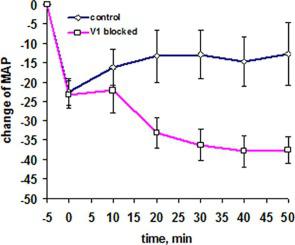Brain Research ( IF 2.9 ) Pub Date : 2021-08-14 , DOI: 10.1016/j.brainres.2021.147618 Ali Nasimi 1 , Fatemeh Haddad 2 , Nafiseh Mirzaei-Damabi 3 , Bahar Rostami 2 , Masoumeh Hatam 2

|
Angiotensin II (AngII) immunoreactive cells, fibers and receptors, were found in the parvocelluar region of paraventricular nucleus (PVNp) and AngII receptors are present on vasopressinergic neurons. However, the mechanism by which vasopressin (AVP) and AngII may interact to regulate arterial pressure is not known. Thus, we tested the cardiovascular effects of blockade of the AngII receptors on AVP neurons and blockade of vasopressin V1a receptors on AngII neurons. We also explored whether the PVNp vasopressin plays a regulatory role during hypotension in anesthetized rat or not. Hypovolemic-hypotension was induced by gradual bleeding from femoral venous catheter. Either AngII or AVP injected into the PVNp produced pressor and tachycardia responses. The responses to AngII were blocked by V1a receptor antagonist. The responses to AVP were partially attenuated by AT1 antagonist and greatly attenuated by AT2 antagonist. Hemorrhage augmented the pressor response to AVP, indicating that during hemorrhage, sensitivity of PVNp to vasopressin was increased. By hemorrhagic-hypotension and bilateral blockade of V1a receptors of the PVNp, we found that vasopressinergic neurons of the PVNp regulate arterial pressure towards normal during hypotension. Taken together these findings and our previous findings about angII (Khanmoradi and Nasimi, 2017a) for the first time, we found that a mutual cooperative system of angiotensinergic and vasopressinergic neurons in the PVNp is a major regulatory controller of the cardiovascular system during hypotension.
中文翻译:

另一个动脉压控制器系统。小细胞室旁核的血管加压素神经网络可能在低血压期间调节动脉压
在室旁核 (PVNp) 的细小细胞区域中发现了血管紧张素 II (AngII) 免疫反应性细胞、纤维和受体,而血管加压素能神经元上存在血管紧张素 II (AngII) 受体。然而,加压素 (AVP) 和 AngII 相互作用以调节动脉压的机制尚不清楚。因此,我们测试了阻断 AngII 受体对 AVP 神经元的心血管作用和阻断血管加压素 V1a 受体对 AngII 神经元的心血管作用。我们还探讨了 PVNp 加压素是否在麻醉大鼠低血压期间发挥调节作用。股静脉导管逐渐出血可诱发低血容量性低血压。注入 PVNp 的 AngII 或 AVP 产生升压和心动过速反应。V1a 受体拮抗剂阻断了对 AngII 的反应。对 AVP 的反应被 AT1 拮抗剂部分减弱,而被 AT2 拮抗剂大大减弱。出血增强了对 AVP 的升压反应,表明在出血期间,PVNp 对加压素的敏感性增加。通过出血性低血压和双侧阻断 PVNp 的 V1a 受体,我们发现 PVNp 的加压素能神经元在低血压期间将动脉压调节至正常。结合这些发现和我们之前关于 angII 的发现(Khanmoradi 和 Nasimi,2017a),我们首次发现 PVNp 中血管紧张素能和血管加压素能神经元的相互协作系统是低血压期间心血管系统的主要调节控制器。表明在出血期间,PVNp 对加压素的敏感性增加。通过出血性低血压和双侧阻断 PVNp 的 V1a 受体,我们发现 PVNp 的加压素能神经元在低血压期间将动脉压调节至正常。结合这些发现和我们之前关于 angII 的发现(Khanmoradi 和 Nasimi,2017a),我们首次发现 PVNp 中血管紧张素能和血管加压素能神经元的相互协作系统是低血压期间心血管系统的主要调节控制器。表明在出血期间,PVNp 对加压素的敏感性增加。通过出血性低血压和双侧阻断 PVNp 的 V1a 受体,我们发现 PVNp 的加压素能神经元在低血压期间将动脉压调节至正常。结合这些发现和我们之前关于 angII 的发现(Khanmoradi 和 Nasimi,2017a),我们首次发现 PVNp 中血管紧张素能和血管加压素能神经元的相互协作系统是低血压期间心血管系统的主要调节控制器。



























 京公网安备 11010802027423号
京公网安备 11010802027423号